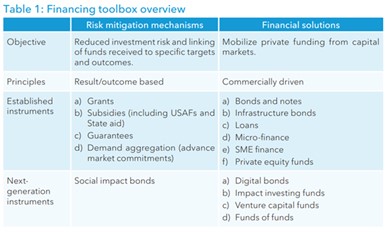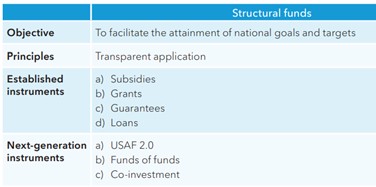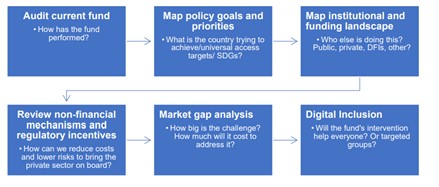Financing universal access to digital technologies and services
01.09.2025Over the past two decades, as the digital sector has become increasingly central to daily life, universal access funding approaches have undergone major transformations. These changes span both the broader development finance landscape and the specific realm of digital infrastructure. Public funding strategies must now reflect this shift—prioritizing the pooling of financial resources, promoting open-access infrastructure, and using public capital to catalyze private investment. The overarching objective is to maximize the impact of limited financial and non-financial resources, ensuring that digital inclusion keeps pace with digital transformation. To that end, key trends include:
a) Using a combination of monetary and non-monetary, or in-kind, contributions, based on project needs and the various strengths of collaborative financiers;
b) Making smarter investments and moving away from “funding” (out of a moral imperative) to “financing,” which is more commercially grounded and relates to making good investments, while contributing to socio-economic development; and
c) Increasing collaboration between governments, commercial banks, development finance institutions (DFIs), the private sector and bilateral and multilateral donor organizations to meet funding gaps, including through blended finance or the strategic use of development finance to mobilize additional finance for sustainable development in developing countries.
Governments will have to find ways to ensure economic growth and productivity by harnessing innovative business models and strategies that support the expansion of broadband networks, as well as digital adoption, use and inclusion.
A 2021 ITU report, Financing universal access to digital technologies and services, provides the context for the collaborative and high-impact universal access financing required to bridge the digital divide. It explains why broadband and digital transformation matter, i.e., for economic growth and inclusion, and that a key factor that deters investment is risk. Governments have a key role to play in reducing macro-economic, political and regulatory risk, which will in turn reduce costs and increase investment. Financing priorities are explored, as are the potential funders for digital transformation. The report notes that there are myriad potential financiers for universal access and public money should only be used where private capital does not intend to go, or where the injection of public money will bring about a significant step change without distorting competition.
The funding gap is not monolithic and considers the different gaps that exist, in terms of gender, infrastructure and schooling, and the challenges that the significant costs of closing them pose. It is acknowledged, however, that in the medium term, the most significant funding gap, in quantum, relates to broadband infrastructure deployment that supports digitalization. Although the costs related to encouraging adoption, use and innovation are low relative to infrastructure deployment and maintenance costs, the associated risks are higher. Furthermore, all costs must be dealt with in parallel to create a people-centred and holistic user experience. Ultimately, it proposes that the fundamental funding policy and regulatory challenge is to make servicing rural and low-income areas and populations worth the investment risk for the private sector and co-investors.
Complementing the report, the Universal Service Financing Efficiency Toolkit explores the principle of blended finance as a means of mobilizing private investment. Various funding instruments are discussed with a particular focus on structural funds, including universal service and access funds (USAFs).
As detailed in the Toolkit, a number of funding mechanisms can be applied to universal access and service interventions broadly, including:
- Standard financial products such as loans, microfinance and SME finance, impact investing funds, and private equity funds. Innovative financial products include venture capital funds, social impact funds, green bonds and digital bonds.
- Risk mitigation mechanisms, which seek to reduce the high levels of perceived risk that often hold back private capital – these include subsidies, guarantees and insurance.
- Result-based financing, also known as outcome-based aid, such as social impact bonds and advance market commitments.
- Technology enabled funding via blockchain, crowdfunding and other digital technologies.


Source: ITU, Financing universal access to digital technologies and services.
Obligations such as regulated universal service funds (pay) and/or license conditions (play) models – including universal service obligations, whether financial (like USFs) or in-kind (such as roll-out requirements) – are fundamental components of the universal access framework in the ICT and digital sector. These obligations are currently being reviewed and reassessed in light of new evidence regarding their effectiveness.
The fund journey has been bumpy, so much so that in many countries it is time to rethink the concept and institution. The report provides alternative fund models, including co-investment funds and funds of funds, which have achieved some level of success in addressing more high-risk financing, such as for SME development and accelerators. Elements from these models are proposed as well as a way forward for “USAF 2.0” as the scope extends beyond infrastructure to digital transformation. These considerations also dovetail with the Toolkit. Of course, just as there is no single financing solution for universal access, there is no single response to the question about the role and relevance of the USAFs currently operational across the world, nor is there a single model for any future USAF (Funds 2.0). Solutions will differ according to the country context and each fund’s historical performance, which is informed by its legal and institutional framework and administrative and operational capacity, in addition to a number of other factors that are explored in the report.
Steps to review Funds

Source: ITU, Financing universal access to digital technologies and services
Fund 2.0 differentiates itself by adding an advisory or facilitating role to its funding role. The advisory role entails facilitating collaboration. Historically, Funds have mainly used their own funds collected through the disbursement of grants and subsidies through a least cost subsidies and competitive bidding process. In addition to issuing grants and subsidies, Fund 2.0 now encourages Funds to co-invest, pool resources, and leverage funds to stretch its resources and impact. This new form of funding is called blended financing.
Non-financial mechanisms are available to mitigate risk – regulatory and policy incentives. Collaboration, pooling, and leveraging are key themes – as much for non-financial incentives as for financial approaches. To that end, this section suggests some policy and regulatory actions that can assist in encouraging investment in infrastructure and promoting adoption, innovation and digital inclusion. They range from “dig once” and “dig smart” policies, which address infrastructure investment challenges, to regulatory sandboxes, which can facilitate innovation. All the regulatory measures in this section, including regulatory forbearance, are discussed as means of lowering costs, reducing risk and ultimately facilitating financing.
Programmes, projects and practices are also examined. It focuses on business models for deploying various supply and demand-side projects and initiatives, ranging on the supply side from traditional public-private partnerships (PPPs) to bottom-up community-based wireless broadband models. On the demand side, the practices are wide ranging and address gaps in digital literacy and adoption by individuals, households, strategic public institutions (e.g., schools and hospitals) and SMEs. Filling these gaps requires innovative thinking that shifts the focus from connecting people to networks to connecting people to other people via networks.
Given the various funding gaps, the myriad funders and financiers, and the significant capital requirements, pooling, collaboration and cooperation will be central to financing universal access to digital technologies and services. In addition to the infrastructure funding challenges for high-cost, low-margin, rural, and remote areas and underserved communities, additional funding requirements relate to facilitating people’s participation in the digital era, i.e., digital adoption, innovation and digital inclusion. Ensuring the effective participation of vulnerable and marginalized communities, in particular, needs to be intrinsic to all universal access initiatives and projects. The economic cost of exclusion is higher than the cost of closing the infrastructure, affordability, gender and other gaps that persist as the world becomes increasingly digitalized.
To access the full report click here.
Further developments and considerations
In addition to the tools identified in the report and the toolkit, it is important to consider the ongoing evolution of the ICT sector and the mechanisms and approaches employed by stakeholders to access the capital required to expand broadband access and improve affordability.
Approaches to financing universal access are considered by both private-sector and public-sector stakeholders. For instance, network operators have undertaken transactions or reorganizations that provide capital that can be used to invest in infrastructure and services. These transactions can include complete or partial sales of passive infrastructure such as towers, such as MTN’s 2022 sale of more than 5,700 towers to IHS Towers or Millicom’s sale of approximately 7,000 towers across five Central American countries (MTN 2022, Millicom International Cellular 2024). While multiple factors are considered when planning such transactions, one frequent consideration is how to best position operators to continue operating and growing their services, including by expanding their customer bases.
In addition, as noted in [link to main Access for All section], private-sector entities including content and application providers (CAPs) continue to invest in submarine cables as well as national-level backbone and middle-mile infrastructure. These investments similarly benefit both the investors seeking to increase capacity to deliver services and the overall growth and expansion of connectivity infrastructure.
Public financing approaches continue to play a significant role in ensuring and expanding access to broadband. A recent OECD review notes that funding approaches in the ICT sector continue to align with examples provided in the Toolkit. These include distributions by relevant authorities and the establishment of entities for fund management, as well as public-private partnerships and blended financing arrangements that include both public and private interests (OECD 2024). One example of joint public financing highlighted by the OECD is found in Slovenia, where the government has co-financed broadband network construction via consortiums that include municipalities, operators, and ministries, as well as private financing. The involvement of multiple stakeholders’ resources both distributes the financial commitment and ensures the consideration of multiple viewpoints and priorities.
Public financing can take the form of investments in technology or networks that can improve public services while also strengthening the financial security of a technology provider. As access technology choices continue to expand and mature, public funds have extended beyond the provision of terrestrial fixed and wireless infrastructure. For example, the Canadian government committed nearly USD 500 million to obtain capacity on the satellite constellation deployed by Telesat (Government of Canada 2021). This funding provides guaranteed funding to Telesat while also providing the government with a means to offer broadband connectivity to ISPs serving rural and remote areas at a subsidized rate. This approach not only subsidizes the expansion of coverage, but demonstrates the Canadian government playing a more active role in both supporting an alternative connectivity technology and ensuring its distribution to underserved communities. Satellite technology has also been leveraged in Mexico, where the Federal Electricity Commission entered into an agreement with Starlink to provide backhaul service for a project to expand connectivity to remote areas and all municipal seats (Reuters 2023).
Universal access financing continues to draw upon the tools and mechanisms highlighted in the Toolkit, while also continuing to leverage new combinations of stakeholders, financing sources, and technologies to meet connectivity needs.
References
Government of Canada. 2021. Universal Broadband Fund and Telesat low Earth orbit capacity agreement, https://www.canada.ca/en/innovation-science-economic-development/news/2020/11/universal-broadband-fund-and-telesat-low-earth-orbit-capacity-agreement.html.
Millicom International Cellular. 2024. Millicom (Tigo) and SBA Communications agree to long-term partnership in Central America. https://www.globenewswire.com/news-release/2024/10/28/2970332/0/en/Millicom-Tigo-and-SBA-Communications-agree-to-long-term-partnership-in-Central-America.html.
MTN. 2022. IHS Towers Completes Acquisition and Lease Back Agreement with MTN in South Africa. https://www.mtn.com/ihs-towers-completes-acquisition-and-lease-back-agreement-with-mtn-in-south-africa/.
OECD. 2024. Financing Broadband Networks of the Future. https://www.oecd.org/en/publications/financing-broadband-networks-of-the-future_eafc728b-en.html.
Reuters. 2023. Musk’s Starlink wins bid to roll out Mexico’s rural satellite internet -documents. https://www.reuters.com/technology/musks-starlink-wins-bid-roll-out-mexicos-rural-satellite-internet-documents-2023-11-06/.
Last updated on: 09.09.2025